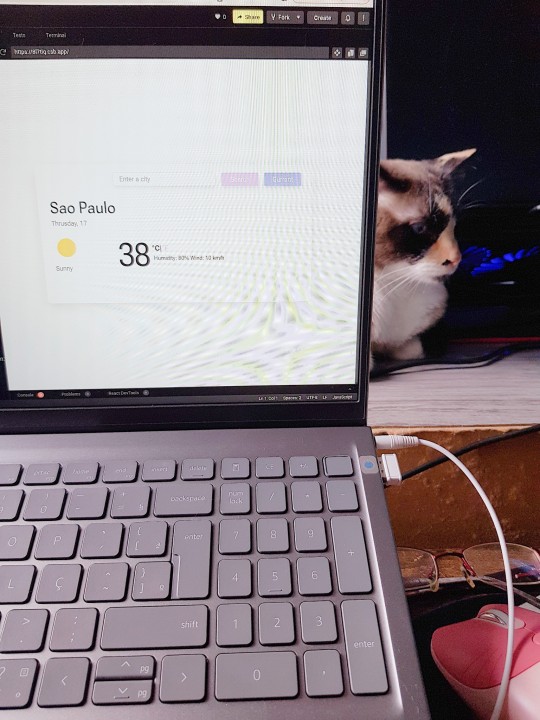#reactjs web development
Explore tagged Tumblr posts
Text
Partner with the Leading ReactJS Web Development Company for Innovative Web Solutions
Partner with the leading ReactJS web development company to create innovative, scalable, high-performance web solutions tailored to your business needs.
#ReactJS web development#ReactJS development company#innovative web solutions#scalable web development#ReactJS services#custom web applications#top ReactJS developers#ReactJS development services#web application development#ReactJS experts
0 notes
Text
Looking for the top ReactJS web development company in the USA for 2024? Our expert team delivers high-performance, scalable web applications using the latest ReactJS technology. Boost your business with cutting-edge web solutions today!
#inwizards software technology#reactjs#ReactJS web development company#ReactJS Development Company#ReactJS Development Service#reactjs development company in usa#ReactJS Web Development
0 notes
Text
When Is the Best Time to Hire a ReactJS Web App Development Company? Hiring a ReactJS web app development company can significantly impact your business growth and streamline operations. But when is the best time to make that decision? Understanding the right moment can save you time and resources. Here’s when you should consider hiring a ReactJS web development company for your business.
0 notes
Text

How to Do CRUD Operations in ReactJS Development Without an API
Master CRUD operations in ReactJS without the need for an API. Follow this easy-to-understand guide to simplify your development process.
0 notes
Text
0 notes
Text
The Art of ReactJS Web Development: How Expert Solutions Redefine Digital Experiences
The essence of ReactJS web development unfolds in seamless innovation. Elevate your digital presence with tailored solutions crafted by skilled developers. Transform possibilities into reality with our expert touch.
#ReactJS Development#ReactJS Development Company#ReactJS Development Services#reactjs web development
0 notes
Text
ReactJS Development Service for Scalable and Dynamic Websites! Create Stunning Websites with ReactJS Web Development Service
ReactJS web development service is the process of creating interactive and user-centred interfaces for websites and web applications using the ReactJS library. ReactJS web development service is a popular JavaScript library for building single-page applications (SPAs) and other dynamic web experiences.ReactJS is a JavaScript library that is widely used for building user interfaces (UI) in web applications. Benefits of ReactJS Web Development Service:--
1.Component-based architecture: Makes code reusable and easier to maintain.
2.Virtual DOM: Improves website performance by minimising DOM manipulations.
3.Large community and ecosystem: Offers a wide range of libraries, tools, and resources.
4.SEO-friendly: SPAs built with ReactJS can be indexed by search engines.
5.Mobile-friendly: Can be used to develop cross-platform mobile apps with React Native. ReactJS utilises a virtual DOM and efficient rendering techniques. This results in faster loading times for websites, as only the necessary components are updated when there are changes. ReactJS optimises the rendering process, allowing you to access website content more quickly.
There are Various services includes in ReactJS web development :--
1.Front-end development: Building user interfaces with ReactJS components.
2.Backend integration: Connecting the ReactJS app to backend services.
3.State management: Managing data flow and state changes in the ReactJS app.
4.Performance optimization: Optimizing the ReactJS app for performance. 5.Deployment and maintenance: Deploying the ReactJS app to production and providing ongoing maintenance.
#ReactJS#ReactJS web development#ReactJS web development service#Grintech web agency#ReactJS web development agency
0 notes
Text
0 notes
Text
Why Choose React and Node.js for Web App Development - If you are looking to build a full-stack web application then discover the power of React with Node.js. Here you can easily understand why Choose React and Node.js. Read this blog to know about Key Benefits and Advantages of choosing them.
#mobile app development company india#app development company india#ingenious minds lab#mobile app development service india#reactjs developers#reactjs development company#reactjs web development#web development#nodejs#NodeJS App Developer India#NodeJS Developer India
0 notes
Text
Discover the Benefits of ReactJS Web Development
Discover the benefits of ReactJS web development and boost your business growth. Build your website with the best web development company in USA-Shiv Technolabs. Contact us today!!

1 note
·
View note
Text
ReactJS Online Training In Hyderabad|Nareshit

0 notes
Text
Explore the Benefits of Node.js and React Together in Full-Stack Web Development

Consider a cutting-edge pair of technologies that collaborate to power the most creative and engaging web experiences. Node.js with React is a developer’s dream come true.
Consider Node.js to be the charismatic conductor of the server-side orchestra. It enables Node.js developers to build versatile, fast backends that can handle thousands of concurrent connections.
It’s a sophisticated JavaScript runtime platform that allows you to build versatile and fast backends. Node.js is capable of handling thousands of concurrent connections, making it ideal for real-time applications and microservices.
Now, let’s introduce React, an interesting and adaptive JavaScript toolkit for creating user interfaces. React allows you to develop visually appealing, interactive frontends that are a pleasure to use. It supports the idea of reusable components, allowing you to create UI elements that can be simply inserted into any portion of your program, assuring consistent and efficient development.
So, whether you’re a Node.js developer, a web app development enthusiast, or just getting started with React web development, embracing the Node.js/React fusion will open up new avenues for creating outstanding web applications.
Benefits of Using Node.js in Full-Stack Development
You can write both frontend and backend code in JavaScript with Node.js, leading in a unified and effective development environment. This reduces difficulty and increases productivity by eliminating the need to transition between languages.
Let’s dive deep and learn more benefits of Node.js.
Enhanced Developer Skill Set:
By embracing full-stack JavaScript frameworks, developers can broaden their skills and become proficient in a single language that is highly versatile and in demand.
Small Memory Footprint:
Node.js is based on the V8 JavaScript engine, which is well-known for its memory management efficiency. As a result, compared to other server-side technologies, Node.js has a modest memory footprint.
Rapid Prototyping and Development:
With Node.js and npm, developers can quickly prototype and develop applications. With a plethora of ready-to-use packages at their disposal, developers may easily assemble the basic building blocks of their apps.
Benefits of Using React in Frontend Development
Using React in frontend development provides a plethora of benefits, making it a popular choice among developers. Here are several significant advantages:
Maintainability:
Individual components in a component-based design can be changed and updated without affecting the entire application. This simplifies maintenance and bug fixing because faults can be isolated to certain components.
Virtual DOM and Efficient Rendering:
When the application state changes, React’s virtual DOM efficiently updates only the necessary components of the user interface. When opposed to directly modifying the DOM, this leads to faster rendering and better performance.
Cross-platform Development:
Developers may use React Native to write code once and release it on both the iOS and Android platforms. When opposed to creating distinct codebases for each platform, this greatly reduces development time and effort.
Here’s why this is advantageous:
Consistent language: JavaScript is versatile and can be used for both front-end and back-end development. With Node.js and React, you can have a unified language and development approach for your entire stack. This eliminates the need for switching between different languages and improves productivity and code maintenance.
Developer expertise: JavaScript is a popular programming language that many developers are already familiar with. You may leverage your development team’s existing expertise and talents by using JavaScript on both the client and the server. JavaScript developers may simply switch between front-end and back-end development, making it easier to cooperate and share duties within the team.
An abundance of libraries and frameworks: Node.js and React boast thriving communities with extensive libraries, frameworks, and tools. These resources cover authentication, database integration, testing, state management, routing, UI components, and more. Leveraging this ecosystem saves development time by incorporating widely used packages.
Active and supportive communities: Node.js and React have thriving developer communities that provide support, resources, and collaborative learning opportunities.
Efficient server-side rendering: Node.js enables efficient server-side rendering (SSR) of React components, optimizing performance by reducing initial page load time and enhancing SEO.
Conclusion :
The usage of Node.js in the backend provides advantages such as using a single language (JavaScript) throughout the entire stack, efficient server-side rendering, real-time data synchronisation, code reusability, access to a vibrant ecosystem, high performance, and improved developer productivity. Node.js allows developers to use their JavaScript skills while simultaneously offering an adaptable, reliable server environment, as well as fostering code sharing and uniformity.
Originally published by: Benefits of Node.js and React Together in Full-Stack Web Development
#Hire NodeJS Developer#NodeJS Development Company USA#Hire ReactJS Developers#React Libraries#ReactJS Web Development
0 notes
Text
JavaScript Fundamentals
I have recently completed a course that extensively covered the foundational principles of JavaScript, and I'm here to provide you with a concise overview. This post will enable you to grasp the fundamental concepts without the need to enroll in the course.
Prerequisites: Fundamental HTML Comprehension
Before delving into JavaScript, it is imperative to possess a basic understanding of HTML. Knowledge of CSS, while beneficial, is not mandatory, as it primarily pertains to the visual aspects of web pages.
Manipulating HTML Text with JavaScript
When it comes to modifying text using JavaScript, the innerHTML function is the go-to tool. Let's break down the process step by step:
Initiate the process by selecting the HTML element whose text you intend to modify. This selection can be accomplished by employing various DOM (Document Object Model) element selection methods offered by JavaScript ( I'll talk about them in a second )
Optionally, you can store the selected element in a variable (we'll get into variables shortly).
Employ the innerHTML function to substitute the existing text with your desired content.
Element Selection: IDs or Classes
You have the opportunity to enhance your element selection by assigning either an ID or a class:
Assigning an ID:
To uniquely identify an element, the .getElementById() function is your go-to choice. Here's an example in HTML and JavaScript:
HTML:
<button id="btnSearch">Search</button>
JavaScript:
document.getElementById("btnSearch").innerHTML = "Not working";
This code snippet will alter the text within the button from "Search" to "Not working."
Assigning a Class:
For broader selections of elements, you can assign a class and use the .querySelector() function. Keep in mind that this method can select multiple elements, in contrast to .getElementById(), which typically focuses on a single element and is more commonly used.
Variables
Let's keep it simple: What's a variable? Well, think of it as a container where you can put different things—these things could be numbers, words, characters, or even true/false values. These various types of stuff that you can store in a variable are called DATA TYPES.
Now, some programming languages are pretty strict about mentioning these data types. Take C and C++, for instance; they're what we call "Typed" languages, and they really care about knowing the data type.
But here's where JavaScript stands out: When you create a variable in JavaScript, you don't have to specify its data type or anything like that. JavaScript is pretty laid-back when it comes to data types.
So, how do you make a variable in JavaScript?
There are three main keywords you need to know: var, let, and const.
But if you're just starting out, here's what you need to know :
const: Use this when you want your variable to stay the same, not change. It's like a constant, as the name suggests.
var and let: These are the ones you use when you're planning to change the value stored in the variable as your program runs.
Note that var is rarely used nowadays
Check this out:
let Variable1 = 3; var Variable2 = "This is a string"; const Variable3 = true;
Notice how we can store all sorts of stuff without worrying about declaring their types in JavaScript. It's one of the reasons JavaScript is a popular choice for beginners.
Arrays
Arrays are a basically just a group of variables stored in one container ( A container is what ? a variable , So an array is also just a variable ) , now again since JavaScript is easy with datatypes it is not considered an error to store variables of different datatypeslet
for example :
myArray = [1 , 2, 4 , "Name"];
Objects in JavaScript
Objects play a significant role, especially in the world of OOP : object-oriented programming (which we'll talk about in another post). For now, let's focus on understanding what objects are and how they mirror real-world objects.
In our everyday world, objects possess characteristics or properties. Take a car, for instance; it boasts attributes like its color, speed rate, and make.
So, how do we represent a car in JavaScript? A regular variable won't quite cut it, and neither will an array. The answer lies in using an object.
const Car = { color: "red", speedRate: "200km", make: "Range Rover" };
In this example, we've encapsulated the car's properties within an object called Car. This structure is not only intuitive but also aligns with how real-world objects are conceptualized and represented in JavaScript.
Variable Scope
There are three variable scopes : global scope, local scope, and function scope. Let's break it down in plain terms.
Global Scope: Think of global scope as the wild west of variables. When you declare a variable here, it's like planting a flag that says, "I'm available everywhere in the code!" No need for any special enclosures or curly braces.
Local Scope: Picture local scope as a cozy room with its own rules. When you create a variable inside a pair of curly braces, like this:
//Not here { const Variable1 = true; //Variable1 can only be used here } //Neither here
Variable1 becomes a room-bound secret. You can't use it anywhere else in the code
Function Scope: When you declare a variable inside a function (don't worry, we'll cover functions soon), it's a member of an exclusive group. This means you can only name-drop it within that function. .
So, variable scope is all about where you place your variables and where they're allowed to be used.
Adding in user input
To capture user input in JavaScript, you can use various methods and techniques depending on the context, such as web forms, text fields, or command-line interfaces.We’ll only talk for now about HTML forms
HTML Forms:
You can create HTML forms using the <;form> element and capture user input using various input elements like text fields, radio buttons, checkboxes, and more.
JavaScript can then be used to access and process the user's input.
Functions in JavaScript
Think of a function as a helpful individual with a specific task. Whenever you need that task performed in your code, you simply call upon this capable "person" to get the job done.
Declaring a Function: Declaring a function is straightforward. You define it like this:
function functionName() { // The code that defines what the function does goes here }
Then, when you need the function to carry out its task, you call it by name:
functionName();
Using Functions in HTML: Functions are often used in HTML to handle events. But what exactly is an event? It's when a user interacts with something on a web page, like clicking a button, following a link, or interacting with an image.
Event Handling: JavaScript helps us determine what should happen when a user interacts with elements on a webpage. Here's how you might use it:
HTML:
<button onclick="FunctionName()" id="btnEvent">Click me</button>
JavaScript:
function FunctionName() { var toHandle = document.getElementById("btnEvent"); // Once I've identified my button, I can specify how to handle the click event here }
In this example, when the user clicks the "Click me" button, the JavaScript function FunctionName() is called, and you can specify how to handle that event within the function.
Arrow functions : is a type of functions that was introduced in ES6, you can read more about it in the link below
If Statements
These simple constructs come into play in your code, no matter how advanced your projects become.
If Statements Demystified: Let's break it down. "If" is precisely what it sounds like: if something holds true, then do something. You define a condition within parentheses, and if that condition evaluates to true, the code enclosed in curly braces executes.
If statements are your go-to tool for handling various scenarios, including error management, addressing specific cases, and more.
Writing an If Statement:
if (Variable === "help") { console.log("Send help"); // The console.log() function outputs information to the console }
In this example, if the condition inside the parentheses (in this case, checking if the Variable is equal to "help") is true, the code within the curly braces gets executed.
Else and Else If Statements
Else: When the "if" condition is not met, the "else" part kicks in. It serves as a safety net, ensuring your program doesn't break and allowing you to specify what should happen in such cases.
Else If: Now, what if you need to check for a particular condition within a series of possibilities? That's where "else if" steps in. It allows you to examine and handle specific cases that require unique treatment.
Styling Elements with JavaScript
This is the beginner-friendly approach to changing the style of elements in JavaScript. It involves selecting an element using its ID or class, then making use of the .style.property method to set the desired styling property.
Example:
Let's say you have an HTML button with the ID "myButton," and you want to change its background color to red using JavaScript. Here's how you can do it:
HTML: <button id="myButton">Click me</button>
JavaScript:
// Select the button element by its ID const buttonElement = document.getElementById("myButton"); // Change the background color property buttonElement.style.backgroundColor = "red";
In this example, we first select the button element by its ID using document.getElementById("myButton"). Then, we use .style.backgroundColor to set the background color property of the button to "red." This straightforward approach allows you to dynamically change the style of HTML elements using JavaScript.
#studyblr#code#codeblr#css#html#javascript#java development company#python#study#progblr#programming#studying#comp sci#web design#web developers#web development#website design#ui ux design#reactjs#webdev#website#tech
397 notes
·
View notes
Text
Embracing ReactJS for Enterprise Application Development in 2024
Clearly, you’re seeking strategies to boost your business productivity. And for this, developing a high-level application that aligns with your business needs is the primary focus. A properly structured application can easily manage large databases, integrate with third-party systems, provide real-time analytics, and support various user roles.
0 notes
Text


another day, another cat
today i finished the homework for week 1 of the react course and i had to "recode" the weather app into react components and it was pretty cool.
have a good weekend!
#codeblr#programming#web development#codenewbie#studyblr#coding#webdev#progblr#shecodes#reactjs#react#mine
48 notes
·
View notes
Text
Finally got OAuth working!!!!
The war is over. Figured out the hard way that OAuth makes the routes for you <3
Now I can start coming up with models to store the data from users. If anyone has any ideas on how I should make those relationships with other data tables for songs and artists let me know. I’m going to reblog this post with some of my own ideas.
I also have a login page and dashboard with hard coded data to get a sense of what I want the backend to supply. Good progress! Will also reblog with pictures of that.
#coding#software engineering#baby coder#web developers#web development#nodejs#ruby#spotify api#reactjs#ruby on rails#software development#full stack developer
4 notes
·
View notes